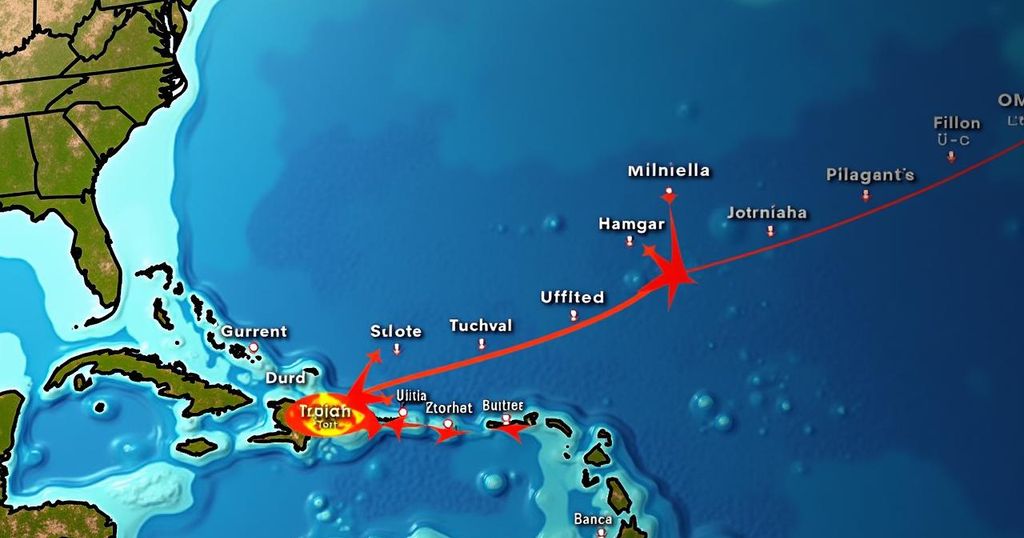Tropical Storm Milton, forming over the Gulf of Mexico, threatens Florida with hurricane-strength winds and heavy rainfall by Wednesday. This storm is the 13th of the season and could impact areas far beyond its predicted landfall. As meteorologists track its path, the potential for major flooding and storm surges raises significant concerns, particularly following the devastation caused by Hurricane Helene, which resulted in over 220 deaths across its trajectory. Current forecasts indicate an active hurricane season with a likelihood of more storms forming. Preparation is critical as communities brace for Milton’s approach.
Tropical Storm Milton has emerged over the Gulf of Mexico, posing a significant threat of hurricane-strength winds and extensive rainfall to Florida, expected by Wednesday, as reported by the National Hurricane Center. Milton is identified as the 13th named storm of the hurricane season, emphasizing its potential impact. As is common with tropical storms and hurricanes, the repercussions of Milton may extend considerably north and south of its anticipated landfall. Should the storm maintain its current trajectory and gain strength to achieve hurricane classification, it will mark the second hurricane to strike Florida within a fortnight, following the catastrophic impact of Hurricane Helene, which landed as a Category 4 storm, resulting in record-breaking storm surges and over 220 fatalities along its path from Florida to Virginia. Understanding how hurricanes form and develop is crucial. Tropical cyclones in the Atlantic Ocean require specific conditions to strengthen sufficiently for classification. Meteorologists at the National Hurricane Center meticulously monitor wind speeds, as a storm is designated a tropical storm upon reaching sustained winds of 39 mph for at least a minute. Once wind speeds reach 74 mph, it escalates to Category 1 hurricane status and can develop through the five established categories, each reflecting potential hazards and damage. The implications of a storm’s winds are severe; tropical storm-force winds can inflict consequential damage, while hurricane-force winds may obliterate structures and propel debris over substantial distances. Furthermore, these winds can cause storm surges—an unprecedented rise in seawater levels, which remains the leading cause of death during hurricanes in the United States, according to the National Weather Service. Large surf waves pose additional risks to both individuals and property. As the storm progresses further inland, the risk of flooding increases significantly. Tropical cyclones typically generate over six inches of rainfall, which can overwhelm existing drainage systems and saturate the ground, leading to flash floods that may last days post-storm. Historically, hurricane season reaches its peak around mid-September, and current indications suggest this season could witness unprecedented activity. The National Oceanic and Atmospheric Administration forecasts between 17 and 25 tropical storms, with a possibility of four to seven developing into major hurricanes. Recent trends also indicate a concerning pattern where hurricanes linger longer, therefore heightening the threat to vulnerable regions. With the devastating effects of Hurricane Helene fresh in public memory, it is imperative to prepare adequately for the forthcoming storm threats.
Tropical Storm Milton represents a significant meteorological event within the Atlantic hurricane season. The formation and development of such storms involve complex interactions of atmospheric conditions that can lead to catastrophic outcomes. The accurate tracking of storms is vital for public safety and preparedness, as reflected by historical data indicating an increase in the frequency and duration of tropical storms. The National Hurricane Center and the National Oceanic and Atmospheric Administration play pivotal roles in monitoring, classifying, and issuing vital warnings related to tropical storm activity. The impending threat of Tropical Storm Milton underscores the importance of understanding the risks associated with hurricanes, including high winds, storm surges, and flooding, all of which necessitate thorough readiness among affected populations.
In summary, Tropical Storm Milton is projected to impact Florida imminently, with the potential for catastrophic wind and rainfall. The increase in tropical storms during this season, coupled with the recent memory of Hurricane Helene, highlights the necessity for heightened vigilance and preparedness against these natural disasters. Understanding the mechanics behind storm formation and the associated risks can significantly aid in mitigating the impacts of such storms on communities.
Original Source: www.washingtonpost.com






